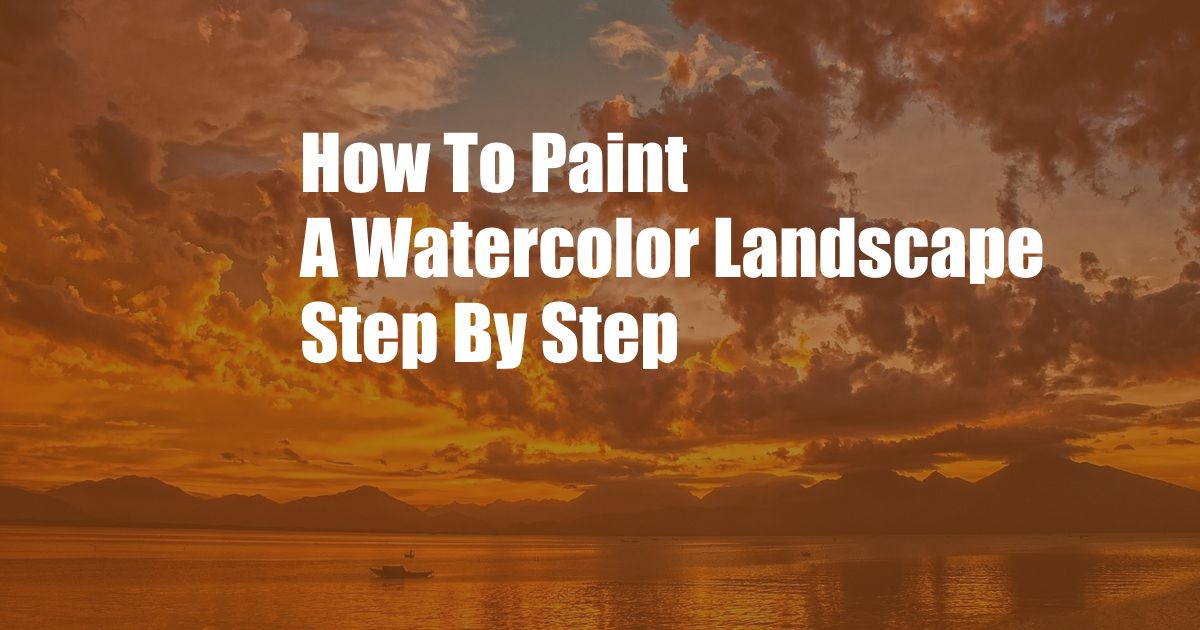
How to Paint a Watercolor Landscape: A Step-by-Step Guide for Beginners
Introduction:
Watercolor painting, with its ethereal beauty and vibrant colors, has captured the hearts of artists for centuries. Its forgiving nature and limitless possibilities make it a perfect medium for beginners and experienced painters alike. In this comprehensive guide, we will take you on a step-by-step journey, unraveling the secrets of painting a breathtaking watercolor landscape.
The Essence of Watercolor:
Watercolor is a water-based medium that uses fine pigments suspended in a binder. This combination creates a transparent, ethereal effect, where colors blend and flow seamlessly on paper. Unlike oil or acrylic, watercolor requires a delicate touch and a keen understanding of the interplay between water and pigment.
Materials and Preparation:
- Watercolor paints: Choose a set with a range of colors, including blues, greens, yellows, and reds.
- Watercolor paper: Heavy, textured paper is ideal for watercolor painting, allowing the pigments to absorb and create vibrant washes.
- Brushes: Use round brushes of various sizes for different effects.
- Palette: A white ceramic palette helps you mix colors and control water content.
- Water: Clean water is essential for mixing watercolor and cleaning brushes.
Step 1: Sketching the Landscape:
Begin by lightly sketching the outlines of your landscape composition. Focus on capturing the essential shapes and forms, leaving out unnecessary details. Use a pencil or charcoal for a soft, erasable line.
Step 2: Establishing the Base Layer:
Wet the paper with clean water and apply the lightest washes of watercolor to establish the sky and ground. Allow the water to flow naturally, creating soft transitions and gradients. Let the base layer dry before proceeding.
Step 3: Defining the Midground and Details:
Add layers of watercolor to define the midground and foreground elements, such as trees, mountains, and buildings. Use a combination of light washes and precise brushstrokes to create depth and texture. Allow each layer to dry before adding more details.
Step 4: Enhancing Depth and Shadows:
To create depth and shadows, use darker washes of watercolor. Apply these shadows gradually, building them up from light to dark. Use a smaller brush for precise details and a larger brush for broader areas of shadow.
Step 5: Adding Highlights and Details:
Once the shadows are established, add highlights and details to enhance the painting. Use white watercolor or tinted shades of white to bring out areas of light. Add fine details with a small brush for a touch of realism.
Tips and Expert Advice:
Mastering Water Control:
- Control the water-to-pigment ratio: Experiment with different amounts of water to achieve the desired transparency and effects.
- Use blotting paper: Lightly blot the brush on blotting paper to remove excess water, preventing muddy washes.
- Wet-on-wet technique: Apply watercolor directly to wet paper, allowing the colors to blend and create soft gradients.
Color Theory and Mixing:
- Understand color harmonies: Study color theory to create harmonious color combinations, such as complementary or analogous hues.
- Mix colors on the palette: Experiment with mixing different pigments to create custom shades and enhance depth.
- Glazing technique: Apply multiple thin layers of transparent watercolor, allowing each layer to dry before adding another.
Frequently Asked Questions:
Q: What paper is best for watercolor painting?
A: Choose watercolor paper with a weight of at least 140 lbs. cold-pressed or rough-textured paper provides good absorption and surface texture for detailed washes.
Q: How do I prevent watercolor from running?
A: Control water flow by lightly dampening the brush and blotting excess water. Use a light touch and avoid overworking the paper.
Q: Can I use gouache or acrylic with watercolor?
A: While gouache and acrylic are water-based, they have different properties and should not be mixed with watercolor.
Conclusion:
Whether you are a seasoned painter or a curious beginner, painting a watercolor landscape is a rewarding experience. By following these step-by-step instructions and embracing the tips and expert advice shared, you can create stunning watercolor landscapes that evoke emotion and capture the beauty of the natural world. Embrace the journey and let your creativity flow with every brushstroke.
Call to Action:
Are you eager to delve deeper into the world of watercolor landscapes? Join our painting workshop or online classes to enhance your skills and explore the endless possibilities of watercolor painting. Let us guide you on your artistic journey!